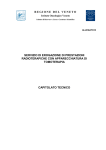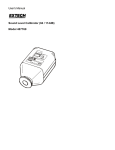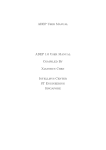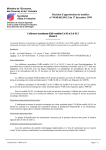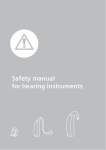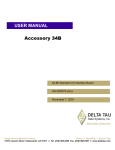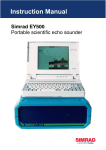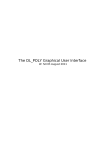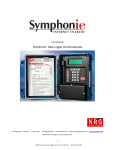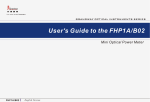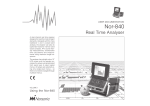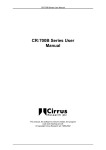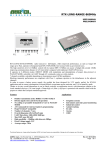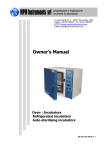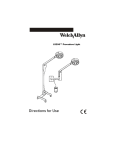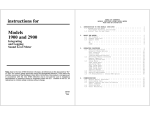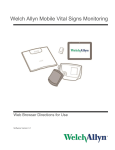Download dBBati Appication Note - Laboratory
Transcript
A P P L I C A T I O N N O T I C E Building acoustics Laboratory measurements TEMPTATIVE 01dB offers a complete system well adapted to both field and laboratory measurements for building acoustics applications. Based upon the Symphonie acquisition system and the dBBATI32 software suite, the following measurements can be performed, according to the specifications of national and international standards currently in use (series ISO 140, ISO 717, ISO 354, ISO 11-654): Sound transmission loss tests Reverberation time tests Sound absorption tests Airborne and impact sound insulation measurements Impulse response measurements Room acoustics criteria : RASTI, STI, clarity, definition The system features numerous functions that will assists the user during the measurement process : Complete system calibration prior to tests MLS measurement mode to improve signal to noise ratio Complete and automatic control of internal signal noise generator (white noise, pink noise, MLS sequence) Endless number of measurement and display set-up, pre-defined by the operator Automatic averaging mode, for successive measurements and between channels Storage of user-defined analysis scripts Tests reports (edition, printing, archiving) A complete range of accessories complements the system : Omni-directional noise source DO12 for airborne noise measurements as defined in ISO 140-3 Directional noise source GdB95 for general airborne noise measurements Tapping machine MAC01 for impact noise measurements Rotating microphone boom, calibrators, cables, etc. All these products are designed for field or laboratory use, and come with batteries and remote control. This application note briefly describes each element of the measurement chain used for building acoustics measurements. PAGE 2 Copyright © BUILDING ACOUSTICS LABORATORY MEASUREMENTS Symphonie system / dBBATI32 Application note 01dB Head Office BP 1126 F-69613 Villeurbanne Cedex FRANCE (33) 4 78 53 96 96 (33) 4 72 33 02 12 01dB Italia s.r.l. Via Berchet, 13 35131 Padova ITALY (39) 49 92 00 966 (39) 49 92 01 239 01dB Inc. 1583 East Genesse Street P.O. Box 796 Skaneateles NY 13152 USA (1) 315 685 3141 (1) 315 685 3194 [email protected] [email protected] Þ http://www.01db.com The specifications are subject to change without notice (E&OE) SYMPHONIE® is a registered trademark of 01dB MICROSOFT® is a registered trademark Microsoft Corporation Windows 95™, Windows 98™ are trademarks of Microsoft Corporation gb_dBBATI32_laboratory.doc – Updated 22/12/99. PAGE 3 TABLE OF CONTENTS 1. OVERVIEW OF THE MEASUREMENT SYSTEM ____________________________________________________ 5 2. INTRODUCTION TO SYMPHONIE SYSTEM FOR BUILDING ACOUSTICS ____________________________ 6 2.1. 2.2. 2.3. 3. DBBATI32 APPLICATION SOFTWARE ____________________________________________________________ 7 3.1. 3.2. 3.3. 3.4. 3.5. 3.6. 3.7. 3.8. 4. OVERVIEW ___________________________________________________________________________________ 6 THE HARDWARE: SYMPHONIE UNIT _________________________________________________________________ 6 THE SOFTWARE SUITE: DBBATI32 _________________________________________________________________ 6 THE ARCHITECTURE ____________________________________________________________________________ 7 RUNNING A MEASUREMENT _______________________________________________________________________ 8 DEFINING MEASUREMENT AND ANALYSIS SET-UPS / TOOLBARS ____________________________________________ 8 LIST OF STANDARDS / TEST REPORTS _______________________________________________________________ 11 THE MLS OPTION _____________________________________________________________________________ 12 CUSTOMISATION ______________________________________________________________________________ 12 OPTIONS: ROOM ACOUSTICS _____________________________________________________________________ 12 VARIOUS ___________________________________________________________________________________ 13 EQUIPMENTS FOR BUILDING ACOUSTICS MEASUREMENTS _____________________________________ 14 4.1. 4.2. 4.3. 4.4. 4.5. 4.6. ROTATING MICROPHONE BOOM NN252_____________________________________________________________ NOISE SOURCES : DO12 AND GDB95 ______________________________________________________________ TAPPING MACHINE MAC01 _____________________________________________________________________ SOUND CALIBRATORS CAL01 / CAL02 _____________________________________________________________ MICROPHONES AND PREAMPLIFIERS _______________________________________________________________ MISCELLANEOUS _____________________________________________________________________________ PAGE 4 14 14 16 16 17 17 1. OVERVIEW OF THE MEASUREMENT SYSTEM Tapping machine MAC01 Noise source DO12 Power amplifiers M700 RAL995 – X m GdB RAL996 – X m Remote control Start / Stop the source External input Symphonie signal generator Analogue transducers Microphones or rotating mic. boom RAL197 – X m Symphonie box on PCMCIA drive Acquisition unit CDP983 – X m CSG990 – X m Computer System control Data storage Application software dBBATI32 Printer on parrallel port Printing results PAGE 5 2. INTRODUCTION TO SYMPHONIE SYSTEM FOR BUILDING ACOUSTICS 2.1. Overview The building acoustics solution offered by 01dB consists in a measuring system and a set of accessories. All these accessories are described in chapter 4. The measuring system is not only a frequency analyser, it is the real heart of a complete and easy to use acoustical laboratory, fully integrated into a computer. The Symphonie system can be either used with desktop computer for laboratory purposes or to a portable computer for field measurements. The 01dB building acoustics software is designed in order to meet the requirements of both applications. But Symphonie is not only versatile, it is a performing and efficient tool for acousticians. The metrological specifications are the state of the art of today (see below) and the ergonomic is the result of many years of experience in the design of Windows based software. 2.2. The hardware: Symphonie unit Symphonie consists of one or two transducers (microphones, rotating microphone boom) connected to a small acquisition unit (the Symphonie unit in itself), which transfers data in real-time to a notebook computer. Symphonie hardware is a powerful two DSP low consumption acquisition unit powered by the notebook Pc-Card (PCMCIA) interface. The design of the unit allows the system to fulfil type 1 specifications of IEC651 and IEC804, while the digital filters fulfil class 0 specifications of IEC1260. As a consequence of this low consumption design, Symphonie does not require any batteries neither any cooling fan and therefore is totally silent (reception noise). The system has received the PTB approval in 1997. The necessary signal conditioning for the microphones (0 or 200V) and the preamplifiers (28V) is directly provided by Symphonie without the need of external units. Symphonie is the newest development in the range of systems from 01dB. Its real-time performance allows simultaneous analyses in both time and frequency domains on 2 channels without any limitation. Symphonie replaces at the same time the traditional measurement instruments (sound level meters, frequency analysers, digital tape recorder, etc….). Audio recordings can be played back directly from the software interface, through the computer sound system. This ability, unique in the marketplace, guarantees a complete and powerful analysis of any noise and vibration application. 2.3. The software suite: dBBATI32 The numerous data processing functions of Symphonie noise and vibration application software packages allows the user to quickly and efficiently generate a measurement report. With the dBBATI32 software package, Symphonie becomes an efficient building acoustics analyser. The dBBATI32 software package allows the user to perform a complete study of any building, including reverberation time and spectrum measurements. Calculations of airborne and impact sound insulation criteria are made according to the international standards currently in use. With its optional MLS acquisition mode, dBBATI32 can also perform short reverberation time and spectral measurements, improving the signal to noise ratio when the background noise level is too high, or the noise excitation level is too low (refer to the corresponding application note). PAGE 6 3. DBBATI32 APPLICATION SOFTWARE 3.1. The architecture The general concept of the software is described in the sketch below. The important point to understand is that the measurements and the process are separated, as it is possible to process audio files that have been recorded on the hard disk of the computer. It means that it is possible to store data and to achieve the process later on. Processing audio files will give the same results as the “real-time” operation, as the audio files are recorded in 16-bit resolution and the calculation routines are strictly identical. Measurement chain configuration (dBCONFIG32) dBBATI32 hardware configuration System calibration MEASUREMENT SELECTION Room criteria Reverberation time Reverberation decay edition Emitted noise Background noise Airborne received noise Impact received noise Spectra HVAC noise Standard or MLS acquisition mode (option) Spectra (+audio records if necessary) Reverberation time Room criteria MEASUREMENT SESSION (CMG) Audio records only Data storage (all types) IMPORT DATA / AUDIO RECORDINGS Spectra ANALYSIS STANDARDISED CALCULATIONS Sound insulation, impact noise, machinery noise, absorption. Edition & execution of requests OFF LINE PROCESSING FUNCTIONS Recombination, arithmetic operations, insulation, etc. PAGE 7 3.2. Running a measurement Nothing is simpler than to run a measurement with dBBATI32. Thanks to the user-defined set-ups, the user will only have to successively click on each icon of the adequate toolbar. It is not only the measurement set-up that is defined but also the interface (tool-bar) and the display. Of course, the hardware configuration is also pre-defined with the help of the transducers database. Then, the step by step process would be defined as follows, for each type of measurement: check the hardware configuration and load the corresponding set-up (refer to Symphonie user’s manual) calibration of the transducers load the set-up corresponding to the measurement push the icons on the tool-bar for each measurement step the data are stored on the hard-disk select the data for the calculation load the set-up for calculations the results are there! The operator has nothing special to do during the measurement as most of the functions are automated: 3.3. autorange function in order to avoid overload or under-range situation automated generator (pre and post delay) automatic averaging between successive measurements and measurement channels Defining measurement and analysis set-ups / toolbars A simple click on the corresponding icon gives access to the measurement toolbar. The user can then customise and configure completely the building acoustics analyser as shown below. All the standardised tests are composed of a sequence of measurements, such as : Emitted noise level Received noise level Reverberation time For each acquisition, specific measurement parameters can be defined. All measurements can be launched from the user-defined tool bar. Therefore, the use of the system can be split in two levels : An expert level for defining the set-ups An operator level, using the pre-defined set-ups, to carry out the measurements. PAGE 8 Acquisition icon tool bar Start a given type of measurement (see next page) Measurement parameters definition Frequency range : 20 Hz – 20 kHz The measurement window itself features self-explanatory icons to drive the acquisition process. PAGE 9 Similarly, the analysis toolbar gives access to the calculation of spectra and reverberation time spectra from the analysis of audio signals : To calculate standardised indices, another user-defined toolbar can be used. ISO standard parameters The easy-to-use interface fastens the set-up process and allows an inexperienced operator to carry out a serie of measurements without alteration of the configuration. PAGE 10 3.4. List of standards / test reports The following indices (single rating values and spectra) can be calculated according to the international standards currently in use. These quantities are Calculated indices Standards AIRBORNE NOISE Raw level difference Dn Standardised level difference Dn,T ISO 140-4 Weighted raw level difference Dn,w Weighted standardised level difference Dn,T,w ISO 717-1 Sound reduction index R ISO 140-3 Apparent sound reduction index R' ISO 140-4 Weighted sound reduction index Rw Weighted apparent sound reduction index R'w ISO 717-1 IMPACT NOISE Normalised impact sound pressure level Ln Normalised impact sound pressure level L'n Standardised impact sound pressure level L'nT Weighted normalised impact sound pressure level Ln,w Weighted normalised impact sound pressure level L'n,w Weighted standardised impact sound pressure level L'n,T, w ISO 140-6 and ISO 140-7 ISO 717-2 SOUND ABSORPTION Absorption coefficient αs Weighted absorption coefficient ISO 354 αw ISO 11654 At the end of the calculations, a test report (with a table and graph) is available, either as an Excel® macro or in the software. The user may insert comments on the measurement conditions, on the geometry of the rooms, etc. The test report can also be printed directly. PAGE 11 3.5. The MLS option As this option is not yet widely used, we think it is useful to explain that this measurement technique, based on a the emission of a MLS signal, allows to obtain better results that the use of a random signal like the commonly used pink noise signal. The MLS (Maximum Length Sequence) is a signal made of impulses, allowing one to obtain the impulse response of the room under investigation. The advantages of this technique are as follows: improvement of the signal to noise ratio of the measurement, better repeatability (reverberation time). It is then possible to measure for example very high sound insulation (that would require extremely high acoustical power with huge amplifiers and sound sources) or to measure the sound insulation with a less powerful sound source (easier to carry for in-situ measurements). The ISO committee in the revision of most building acoustics standards now accepts the MLS generation. It is also an efficient tool for reverberation time measurements, especially in small volumes or very absorbing rooms. When the T60 is very short, classical methods would reach their limits when MLS signal allows to get the results with a good accuracy (refer to the dedicated application note). 3.6. Customisation Since dBBATI32 is adapted to perform measurement according international standards, some users may need an adaptation to some internal or specific procedures or hardware. 01dB can provide an efficient customisation of the software, corresponding to its customers’ specifications. Thanks to the communication features of dBBATI32 and of the computer on which it is running, it is possible to interface various types of hardware, from a special kind of microphone to a 2D or 3D robot for fully automated measurements. 3.7. Options: room acoustics Close to the building acoustics applications, the room acoustics module allows to calculate room criteria from the impulse response measurement, obtained by the use of the MLS generator. The following criteria can be calculated : Echogram in octaves or third octaves Reverberation time Clarity Speech Transmission Index STI Intelligibility RASTI Etc. PAGE 12 3.8. Various The short description mentioned here can be found in details in the respective user’s manuals of Symphonie and dBBATI32. dBBATI32 is provided with on line help file, allowing direct access to measurement procedures, details on a function or even theoretical explanations on how the measured quantities are calculated. dBBATI32 is available in 5 languages: English French German Spanish Italian As most of Windows based software, it is fully compatible with copy/paste operations. All graphs and tables can be printed by any Windows compatible printer. PAGE 13 4. EQUIPMENTS FOR BUILDING ACOUSTICS MEASUREMENTS 01dB offers a complete set of accessories for building acoustics tests: 4.1. Rotating microphone boom NN252 The Norsonic NN252 is an oscillating microphone boom for spatial averaging in building acoustics measurements. It allows measurement to be made as defined in the ISO 140, 3743 and 3822 standards The boom length is adjustable from 0.5 to 1.75 metres, with a sweep rate adjustable from 7 to 32 seconds and a sweep angle adjustable from 60 to 360 degrees, for use in confined spaces. With a very low self noise level, the plane of the traverse may be inclined to the room boundaries. This rotating microphone boom accepts standard microphone preamplifiers and extension cables. For making MLS and reverberation time measurements the NN252 boom may be moved to fixed positions using an optional remote control unit. 4.2. Noise sources : DO12 and GdB95 01dB offers two types of noise sources for airborne noise, a directional source type GdB95 and an omni-directional source type DO12. The latest can be either used with the GdB amplifier or the M700 amplifier, depending of the portability and the sound power output level required. The omni-directional noise source DO12 is made of 12 loudspeakers mounted in a robust dodecahedral cabinet, thus creating a sound field close to an ideal spherical distribution. Coupled with the acquisition systems Symphonie, the noise source DO12 is an ideal accessory for reverberation time measurements, sound reduction index and transmission loss measurements or any general application that require a spherical sound field. Unwanted reflections are kept to a minimum by using a tripod support on wheels, meaning as well that the noise source DO12 can get around more easily. The power delivered by the noise source coupled with its amplifier allows the user to obtain high sound levels to avoid background noise interference during sound insulation measurements. The noise source DO12 is delivered with a tripod support, various cables, an operation manual and a carrying case. PAGE 14 The GDB95 Portable Sound Source is a completely self-contained unit consisting of a noise generator, power amplifier and loudspeaker, powered either from mains or built-in rechargeable batteries. In order to achieve its high power output, the whole assembly of the sound source is heavily built, giving good low frequency output from its bass-reflex loaded driver. To easily carry the GDB95, the cabinet can be split into two separate units, each with carrying handle. The lower cabinet houses a damped 10" drive unit, giving extended bass performance, whilst still giving significant output in the 8kHz octave band, with low distortion. The loudspeaker is protected by a fuse, as is the power amplifier and charger circuit. The GdB amplifier houses the noise generator, with either fixed output in 5 steps of 10dB down from full level, or variable via a large control. Broad band white or pink noise can be selected, and octave filtered noise is also available, for situations where the output power needs to be concentrated, for measurements of high insulation, or high background noise. The measurement instrumentation can also be set to octave filtering for improved signal to noise ratio. Selection of noise type and output level is made via a two line LCD display, with an easy to use menu selection, using up/down arrow keys. An option is also provided for external signal input, so the system can also be used for generating different signals with the fully automated generator module from the Symphonie system. A battery pack allows the user to run the source at full rated output for over an hour, more than enough for most building acoustics applications. Alternatively, the system can be used on mains powering, whilst recharging the internal batteries. Alternatively, the amplifier M700 can also be connected to the DO12 noise source. The amplifier includes a signal generator as well, in order to generate white noise, pink noise and traffic noise. PAGE 15 4.3. Tapping machine MAC01 The tapping machine MAC01 is a lightweight portable impact sound source designed to fulfil the specifications of the standards dealing with impact sound transmission measurements (ISO 140, ASTM E 492, DIN 52210, BS 5821 and ISO 717). With a PC-based measurement system such as Symphonie, and the building acoustics software dBBATI32, the weighted impact sound pressure level Ln,WT may be easily calculated. Made of 5 steel hammers in line, weighting 500 grams each, the tapping machine MAC01 provides a free fall of the hammers equal to 40 mm, as required by the standards. User-interchangeable rubber tipped hammers for special floors are available as an option. Installing the tapping machine MAC01 on-site is very simple. Battery operation ensures a complete freedom of use. The HF remote control (optional) allows the user to operate the tapping machine at a distance during a measurement session in order to limit the duration of the impacts. The tapping machine MAC01 is delivered with a wireless remote control as well as an operation manual. The battery charger is also included. 4.4. Sound calibrators Cal01 / Cal02 The calibrators Cal01 and Cal02 are sound pressure sources dedicated to the on-site calibration of noise measurement systems before and after each measurement session, as defined in most regulations. Battery operated and lightweight, they comply with the specifications of the standard IEC942 as either class 1 (Cal01) or class 2 (Cal02) acoustic calibrators. With its quasi-cylindrical shape, the calibrator is comfortable in the hand, and can be easily used. A single push button enables calibration level. The sound output is stopped automatically without user operation. These devices may be used with either typical sound level meters or PC-based noise measurement systems independently of the weighting network or filter used because of a nominal sound pressure level of 94dB at 1000 Hz. In higher background levels, the sound level of Cal01 can be amplified by 20dB or it may be attenuated by 20dB if, for example, a calibration signal is to be recorded on a digital tape recorder (DAT) in order to use the complete dynamic range of the tape. In order to perform an accurate and valuable calibration in presence of extraneous noise sources that vary greatly, the calibrators Cal01 and Cal02 feature an acoustic and electronic control system driven by a micro-processor and controlled by an internal reference microphone. Cal01 and Cal02 are designed for use with 1 inch microphones and delivered with 1/2 inch microphone adapter. PAGE 16 4.5. Microphones and preamplifiers These ½ inch microphones, prepolarised, allow free field measurements over a large dynamic range (20 dBA to 145dB) and frequency range (2 Hz to 20 kHz), depending on the model. All microphones are designed and manufactured with corrosion resistant materials using an artificial ageing process, so that they are remarkably stable with time. Each microphone is delivered with an individual calibration datasheet. MCE212: Free-field 1/2" pre-polarised microphone to be used where polarization voltage is not available. Type 1 version. MCE210, MCE220: Free-field 1/2" pre-polarised microphones of type 1 and type 2. They are used with the sound level meters developed by 01dB. The PRE 12 preamplifier is designed to be used with electret condenser microphones, pre-polarised or polarised at 200 volts (Type H). Its purpose is to transform the output impedance of a microphone and to therefore allow a reliable use of microphone signals even for long cable lengths. The PRE 12 preamplifier is available in two versions : PRE 12H : Working with all electret microphones, it complies with the most stringent international standards. Its' characteristics are essentially linked to the power supply voltage and cable length. An internal adaptation allows the use of externally polarized electrostatic microphones. PRE 12N : This version is equipped with a switchable capacitive attenuator , which allows the measurement of high sound pressure levels (>130dB) 4.6. Miscellaneous 01dB can provide you with all cables (standard, flat), windshields, microphones adapters and tripods. Please contact you 01dB distributor for more information. PAGE 17
















